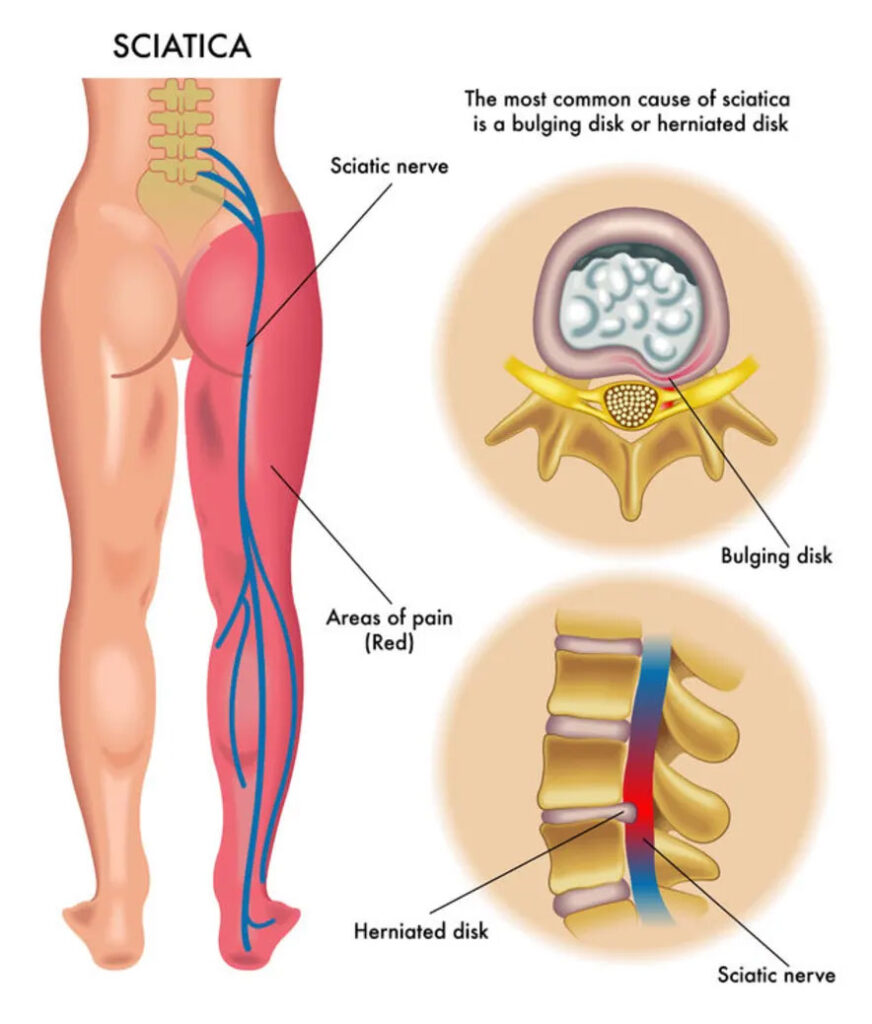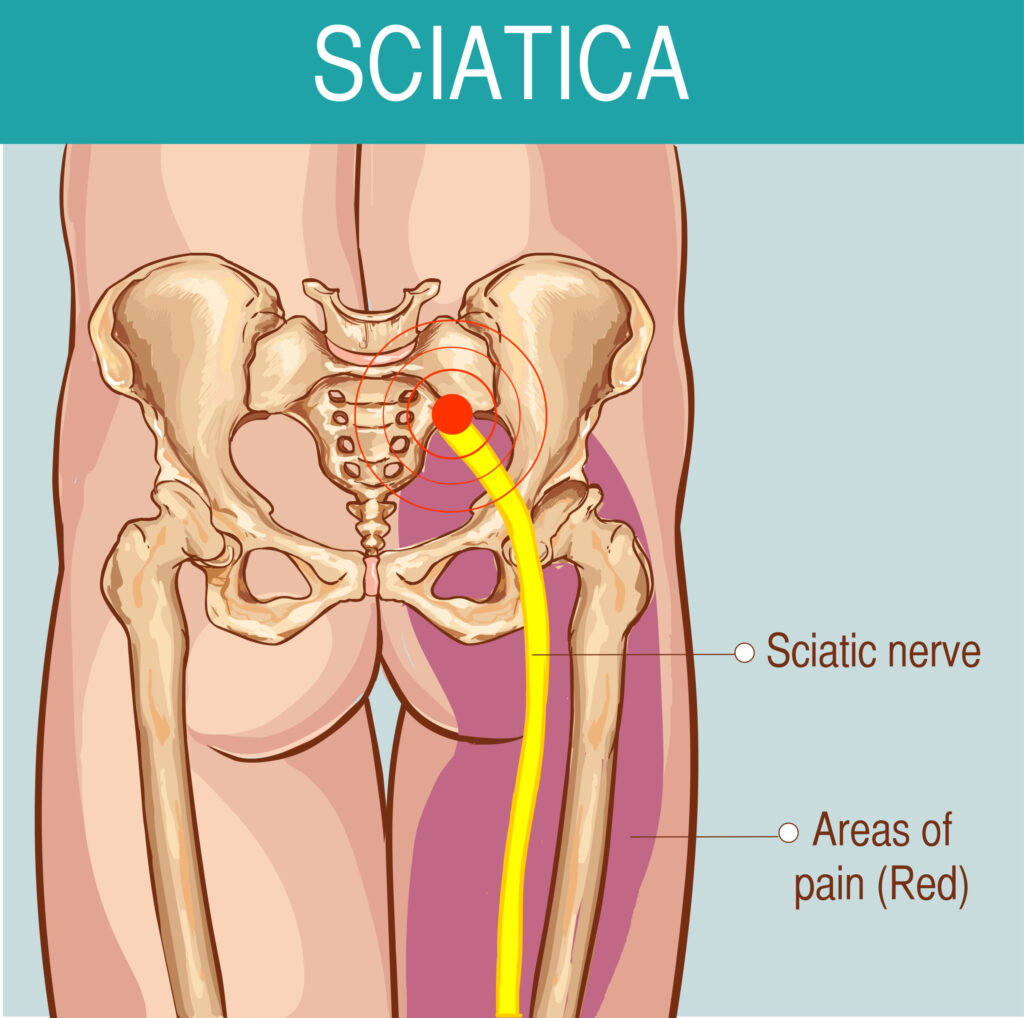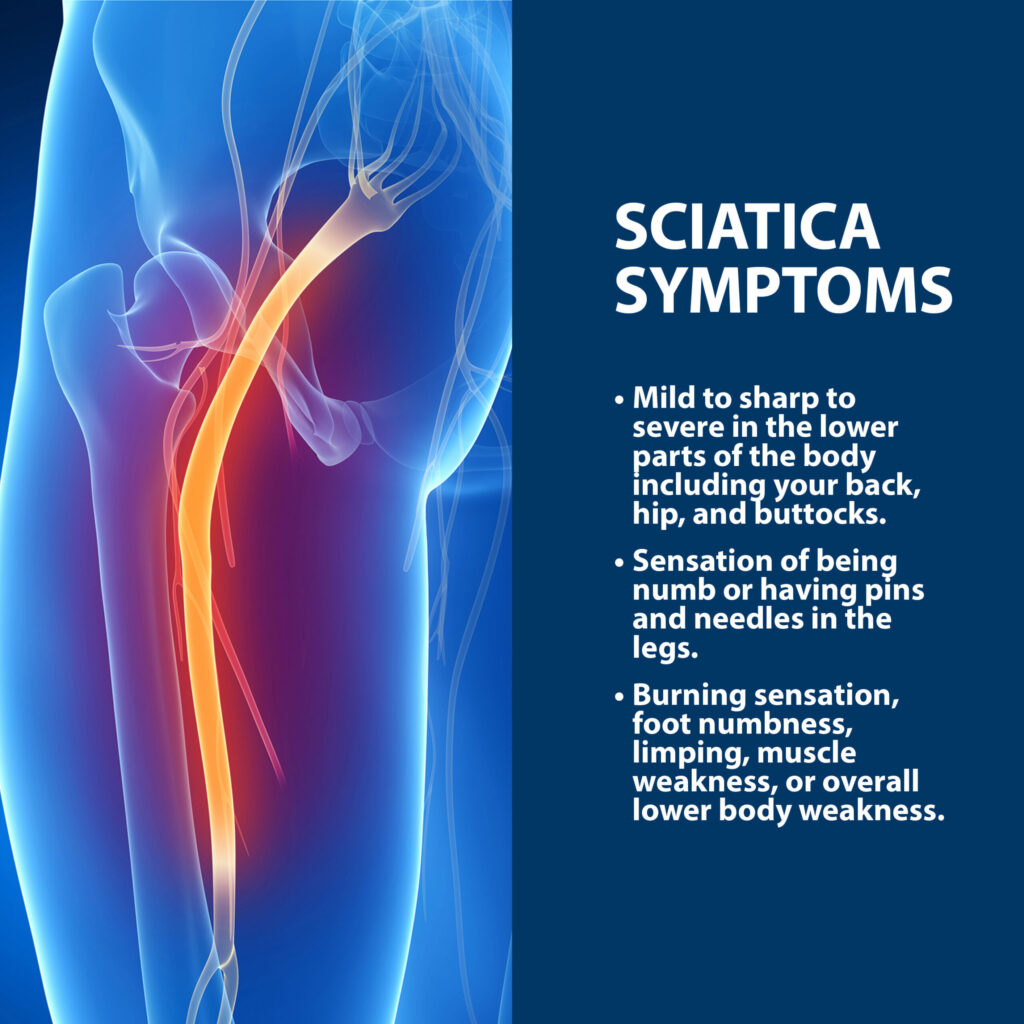Sciatica
Sciatica
Sciatica is a common condition that can cause pain, numbness and tingling in the lower back and legs. While the cause of sciatica is typically unknown, there are many treatment options available to help you manage the nerve pain. In this comprehensive guide, we will discuss the causes, symptoms and treatment options for sciatica. We will also provide tips on how to reduce your risk of developing sciatica. So, if you are suffering from low back pain, read on for advice on how to get relief.

Causes of Sciatica
Sciatica is defined as a pain that radiates along the sciatic nerve, which extends from the lower back to the legs. Sciatica is caused by a variety of conditions that can compress or irritate the spinal nerves, including:
Degenerative disc disease:
This condition occurs when the discs that cushion the vertebrae in your spine begin to deteriorate. This can happen due to age or injury.
Herniated disc:
A herniated disc occurs when the outer layer of a disc tears, allowing the inner layer to bulge out. This can put pressure on the sciatic nerve.
Spinal stenosis:
This condition occurs when the spinal canal begins to narrow, putting pressure on the spinal cord and nerves.
Pregnancy:
The added weight of pregnancy can put strain on the lower back and sciatic nerve.
Sitting for long periods of time:
This can lead to inflammation of the sciatic nerve.
Injury:
An injury to the lower back can also cause sciatica.
Other less common causes of sciatica include pregnancy, bone Spurs, and muscle strain.

Symptoms of Sciatica
Sciatica can cause a variety of symptoms, including:
Pain:
You may feel a dull ache, severe pain, or burning sensation along the sciatic nerve. The pain may radiate from your lower back to your buttock and down your leg.
Numbness:
You may experience a tingling or burning sensation in your leg or foot.
Weakness:
You may have weakness or difficulty moving your leg or foot.
If you are experiencing any of the above symptoms, do not delay in seeking immediate medical attention.

Diagnosis of Sciatica
Sciatica can be difficult to diagnose because it is often confused with other conditions that cause similar symptoms, such as a herniated disc or piriformis muscle syndrome. To diagnose sciatica, your doctor will likely do:
Physical Examination:
Your doctor will ask you about your medical history and symptoms, and then do a physical examination. This will help your doctor rule out other conditions that could be causing your symptoms.
Imaging Studies:
If your doctor suspects you have sciatica, they may order imaging studies such as an MRI or CT scan to confirm the diagnosis.
Nerve Studies:
In some cases, your doctor may order nerve studies to further evaluate the cause of your sciatica. Nerve studies can help rule out other conditions that could be causing your symptoms.
Treatment of Sciatica
Once your doctor has diagnosed you with sciatica, they will work with you to develop a treatment plan. Treatment for sciatica focuses on relieving the pain and other symptoms. This can be done with medication, physical therapy, or surgery.
Medication:
Medication is often the first line of treatment for sciatica. Your doctor may prescribe pain relief medication, muscle relaxants, or anti-inflammatory drugs to help relieve your symptoms.
Physical Therapy:
Physical therapy can help strengthen the muscles around your spine and improve your flexibility. This can help relieve the pressure on your sciatic nerve and reduce your pain.
Surgery:
In some cases, surgery may be necessary to relieve the pressure on your sciatic nerve. Surgery is usually only recommended if other treatments have failed to relieve your symptoms.
Sciatica can be a difficult condition to diagnose because it often masquerades as other conditions with similar symptoms. Your doctor will likely perform a physical examination and order imaging studies such as an MRI or CT scan to confirm the diagnosis. Once you are diagnosed with sciatica, treatment focuses on relieving the pain and other symptoms. This can be done with medication, physical therapy, or surgery.

Tips to prevent Sciatica
Following are some tips which may help you to prevent sciatica:
Avoid risky activities:
Avoid activities which require you to twist your back or bend forwards from the waist. If you absolutely have to do these activities, make sure that you warm up first and take breaks often.
Exercise regularly.
This helps to keep the muscles in your back and legs strong and healthy, which can reduce the likelihood of developing sciatica.
Maintain good posture.
Poor posture puts unnecessary stress on your spine and can lead to sciatica. Make sure that you sit up straight and stand tall.
Use a supportive mattress.
A mattress that is too soft or too hard can put strain on your back, which can lead to sciatica. Choose a mattress that provides firm support.
Wear comfortable shoes.
Shoes that are too tight or have high heels can throw off your posture and cause back pain. Wear shoes that fit well and provide support for your feet.
Stretch your hamstrings.
Hamstring muscles that are tight can cause sciatica. Try doing some gentle stretches to keep these muscles loose.
Manage your weight.
Excess weight can put strain on your back and lead to sciatica. Maintain a healthy weight to reduce the likelihood of developing this condition.
Quit smoking.
Smoking can cause the discs in your spine to degenerate, which can lead to sciatica. If you smoke, quitting is the best thing you can do for your health.
Following these tips may help you to prevent or relieve symptoms of sciatica. However, if sciatica pain persists, it is important to seek immediate medical attention for further evaluation and treatment.
Frequently Asked Questions
Sciatica is a condition that results when the sciatic nerve, which runs from the lower back down the affected leg, becomes irritated or compressed. This can cause chronic pain, tingling, and numbness in the leg. Sciatica can be caused by a variety of things, including a herniated disk, lumbar spinal stenosis, or degenerative disc disease. Risk factors for developing sciatica include age, obesity, and a sedentary lifestyle.
The most common symptom of sciatica is shooting pain that radiates from the lower back down the leg. Nerve roots can become irritated or compressed, causing sciatica. Other symptoms may include tingling, numbness, or weakness in the leg. Sciatica can vary in intensity from mild to severe.
There are a number of treatment options available for sciatica. These include over-the-counter and prescription medications, physical therapy, chiropractic care, and surgery. Treatment will depend on the underlying cause of the sciatica.
There are a few things you can do to help prevent sciatica. These include maintaining good posture, exercising regularly, and avoiding activities that put unnecessary stress on your back.
If you have a job that requires you to sit for long periods of time, be sure to take breaks often and use an ergonomic chair. If you are overweight, losing weight can help reduce the pressure on your spine and sciatic nerve.
The sciatic nerve is the largest nerve in the body. It runs from the lower back down the leg, and gives sensation to the thigh, leg, and foot.
If you are experiencing pain, tingling, or numbness in your leg that radiates from your lower back, you should see a doctor. If left untreated, sciatica can lead to other conditions such as cauda equina syndrome. This is especially true if the symptoms are severe or if they are accompanied by other symptoms such as weakness in the leg or loss of bladder or bowel control. A doctor or pain specialist can determine the underlying cause of the sciatica and recommend appropriate treatment.
Have you been injured at some point in your journey?
Are you not achieving your highest level of function?
We’ve helped hundreds of people at all walks in life
get back to performing their best painfree!
3 Ways to Level Up Your Rehab and Injury Prevention With Us





